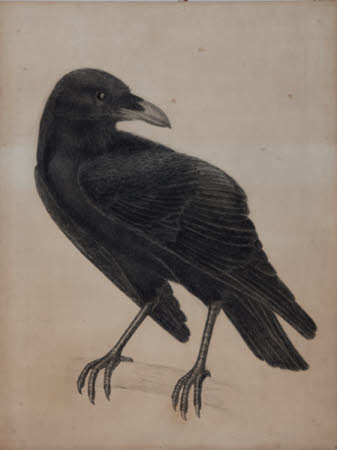The Lion, The Raven, The Hare, The Fox – studies for ‘The Forest’ tapestry
Philip Speakman Webb (Oxford 1831 - West Sussex 1915)
Category
Art / Drawings and watercolours
Date
1886
Materials
Pencil and watercolour on paper
Order this imageCollection
Wightwick Manor, West Midlands
NT 2900066
Caption
Architect, artist and designer Philip Webb (1831–1915) worked closely with his friend William Morris (1834–96), and these four charming animal studies were used in the design of a tapestry known as ‘The Forest’, made by Morris & Co in 1887. The drawings of the hare and the fox demonstrate Webb’s subtle draughtsmanship and eye for detail, while the drawing of the raven perched upon a branch appears keenly observed from life, reflecting Webb’s interest in natural history. The lion, with its perfect mane, curled tail and paused stance, appears more naive in style. These drawings, along with another of a peacock, were scaled up to be turned into patterns, known as ‘cartoons’, which were used by the tapestry makers. The incorporation of spreading leaves, foliage and native wild flowers adds colour and vibrancy to the finished tapestry design (now in the V&A).
Summary
Watercolour and pencil on paper, a set of four preparatory studies for ‘The Forest’ tapestry, Philip Speakman Webb (Oxford 1831 - West Sussex 1915), 1886. The studies depict a fox, a hare, a raven and a lion. The Forest tapestry was designed by William Morris, Philip Webb and John Henry Dearle, and woven at Merton Abbey by William Knight, John Martin and William Sleath, 1887, purchased by Alexander 'Aleco' Ionides and hung in the study of his London residence, 1 Holland Park, now in the collection of the Victoria & Albert Museum, London (inv.no. T.111-1926).
Full description
The Forest tapestry was a collaboration between William Morris (1834-1896) and his friends and fellow designers Philip Webb and Henry Dearle (1859-1932). Webb and Morris met whilst working in Oxford for the architect G.E. Street. They were kindred spirits who shared a deep love of nature and the English countryside. Their creative partnership led to the founding of the visionary furniture and decorative arts firm, Morris & Co. The Forest depicts a peacock, a hare, a lion, a fox and a raven against a plane of lushly verdant acanthus. An array of wild and native flowers line the foreground. Verses contained within two scrolls run across the top of the tapestry, reading ‘The beasts that be in woodland waste, now sit and see nor ride nor haste’. The rich colours, patterns and textures were inspired by medieval tapestries which Morris so admired, the swirling acanthus by large-leaf verdure hangings woven in France and Flanders in the 16th century. These beautifully observed and highly finished pencil and watercolour studies were made in 1866, the Fox dated to Michaelmas Day of that year. They reveal the influence on Webb of the engraver and natural historian Thomas Bewick (1753-1828), whose portrait of a raven is especially close to Webb’s. Albrecht Durer (1471-1528) is recalled in the Hare and the Lion and the botanical accuracy of the native plants and flowers show Webb’s commitment to the Ruskinian ideal of ‘truth to nature’. The studies are faintly traced over with gridlines, indicating that they were scaled up for the cartoon. Woven at Merton Abbey in 1887 by Morris’ senior weavers, the tapestry was purchased by Aleco Ionides (1810-90) and hung at 1 Holland Park, before being sold to the Victoria & Albert Museum in 1926. Webb’s drawings appear to have been retained by Morris & Co. until about 1900, when they were sold to Laurence William Hodson (1864-1933), a brewery owner, for £100. In the 1890s Hodson had appointed Morris & Co. to refurnish his home, Compton Hall, on the outskirts of Wolverhampton. The estate was sold in 1906 but the drawings remained with the family. In 2013 they were offered for sale and were purchased for Wightwick Manor, a Wolverhampton manor house filled by the Mander family with Morris & Co. fittings, fabrics, wallpaper and furniture.
Provenance
Laurence W. Hodson (1863-1915) and thence by descent; sold at Dreweatt Neate, Donnington Priory, on 27 March 2013; purchased by the National Trust from H. Blairman & Sons and Stephen Ongpin Fine Art, 2013 with the assistance of grants from the Art Fund, the V&A Purchase Grant Fund, the Monument Trust, the Mander Trust and a number of individual gifts, 2013.
Makers and roles
Philip Speakman Webb (Oxford 1831 - West Sussex 1915), artist
References
Lethaby 1935, 1979: William Richard Lethaby, Philip Webb and His Work, Oxford 1935, new edn. London 1979 Parry 1983: Linda Parry, William Morris Textiles, London 1983 Parry 1996: Linda Parry (ed.), William Morris, London 1996, pp. 54, 233 Gallagher 2014: Jane Gallagher, 'Four Beautiful Beasts: Philip Webb and the making of Morris's 'The Forest' tapestry', Arts Building & Collections Bulletin, National Trust, Winter 2013-14, pp. 1-4.



